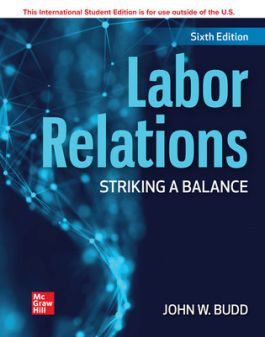Labor Relations ISE
1260590364
·
9781260590364
Budd presents labor relations as a system for balancing employment relationship goals (efficiency, equity, and voice) and the rights of labor and management. By weaving these themes with the importance of alternative perspectives on the nature of emp…
Read More
After purchasing your eBook, login to the McGraw Hill Bookshelf website and redeem the access code from your order confirmation email.
- Access your eBook online or offline
- Easily highlight and take notes
- Fully searchable content
- Syncs across platforms
NOTE: eBook purchase does not include Connect homework or adaptive SmartBook assignments
PART ONE
Foundations
1 Contemporary Labor Relations: Objectives, Practices, and Challenges
2 Labor Unions: Good or Bad?
PART TWO
The U.S. New Deal Industrial Relations System
3 Historical Development
4 Labor Law
5 Labor and Management: Strategies, Structures, and Constraints
6 Union Organizing
7 Bargaining
8 Impasses, Strikes, and Dispute Resolution
9 Contract Clauses and Their Administration
PART THREE
Issues for the 21st Century
10 The Evolving Nature of Work
11 Globalization and Financialization
PART FOUR
Reflection
12 Comparative Labor Relations
13 What Should Labor Relations Do?
Foundations
1 Contemporary Labor Relations: Objectives, Practices, and Challenges
2 Labor Unions: Good or Bad?
PART TWO
The U.S. New Deal Industrial Relations System
3 Historical Development
4 Labor Law
5 Labor and Management: Strategies, Structures, and Constraints
6 Union Organizing
7 Bargaining
8 Impasses, Strikes, and Dispute Resolution
9 Contract Clauses and Their Administration
PART THREE
Issues for the 21st Century
10 The Evolving Nature of Work
11 Globalization and Financialization
PART FOUR
Reflection
12 Comparative Labor Relations
13 What Should Labor Relations Do?
Budd presents labor relations as a system for balancing employment relationship goals (efficiency, equity, and voice) and the rights of labor and management. By weaving these themes with the importance of alternative perspectives on the nature of employment relationship throughout the text, students can learn not only how the traditional labor relations processes work, but also why these processes exist and how to evaluate whether they are working. In this way, students can develop a deeper understanding of labor relations that will help them successfully navigate a contemporary labor relations system that faces severe pressures requiring new strategies, policies, and practices.

